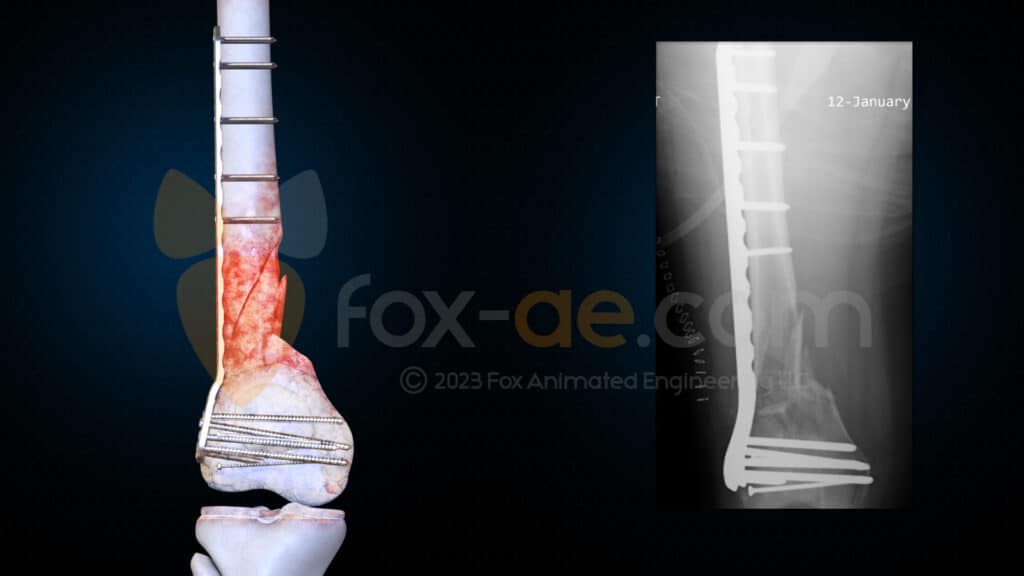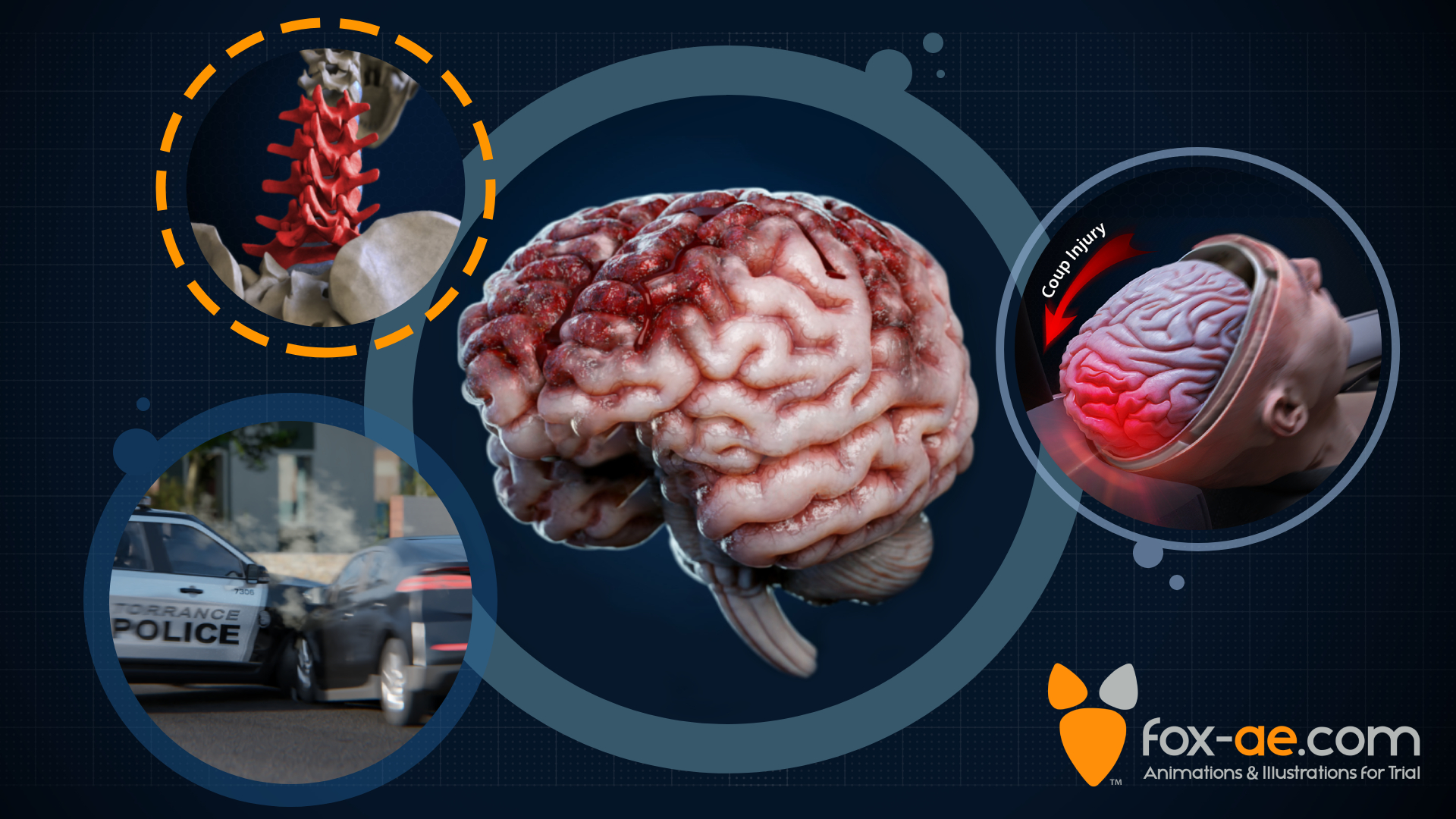Demonstrative evidence refers to exhibits that clarify a testimony or recreate a situation, event, or experiment. These exhibits can be admitted as evidence in a legal case or used by lawyers or witnesses to present important facts and aspects of the trial.
Studies show that 90% of people’s knowledge comes from visual-sensory impressions. In the world of law, demonstrative evidence plays a vital role in presenting strong arguments and easing the understanding of complex legal cases for jurors and mediators.
There are various uses for demonstrative exhibits. For example, accident reconstruction can help the audience visualize the incident, a surgery animation can simplify a complex medical intervention, and a construction virtual reality animation can allow the viewer to experience the construction process.
The uses of demonstrative evidence are countless, and here are the ten most effective demonstrative evidence uses that Fox AE has worked on:
Work Injury – Accident Reconstruction Demonstrative Evidence
An employee without certified training was involved in an explosion caused by high-voltage electricity.
As instructed by his supervisor, an employee without electrical/safety training climbs a ladder to take a picture of 480V bus bars inside a bus duct. The animation shows the employee’s entire body being lit on fire by an electrical explosion as he tries to do his job.
The next video is a typical work injury due to a lack of safety measures in a reconstruction project. Proper implementation of safety measures could have prevented bodily injuries, including bruises, shoulder dislocation, disc herniation, neck fracture, and muscle tears caused by a roof collapse during work.
The animation above explains the extent of damages and the safety measures that could have been implemented before the incident.
Other examples of work injury demonstrative evidence:
Clearly Show Spinal Injuries
Improper Safety Measures Cause Roof Collapse
Vehicular Accident Reconstruction
Breaking the law leads to a dangerous collision. Watch an illustration showcasing a cop doing an illegal U-turn across lanes.
The exhibit demonstrated how the reckless act of not following guidelines caused a dangerous collision.
Another example of a vehicular accident reconstruction demonstrative exhibit is a wet road collision.
It’s challenging to determine what happened at the scene of a crash without dash cams and with wet road conditions. In vehicle collision cases, the defendant’s and plaintiff’s statements are often the only evidence provided. However, we provide an engineering level of precision and accuracy by utilizing crash reports and all available evidence to demonstrate the collision perfectly.
Other examples of vehicular accident recon demonstrative evidence:
Wrong Reaction to Collision Avoidance System
Disobedient Driver Causes Collision
Speeding Semi at Night Causes Fatalities
Improper Safety Measures Cause Roof Collapse
Construction Animation
Due to the improper ventilation system installation, many apartments in this building had severe cases of mold. How can improper ventilation cause mold build-up?
Some other construction examples:
$100,000,000 Construction Case – Won
Demonstrative Evidence as Virtual Reality
Step into the future of construction with this virtual reality animation.
Explore the building designs in a fully immersive experience, seeing every detail come to life before your eyes.
From foundation to rooftop, experience the building’s creation as if you were on the construction site.
Medical Surgery
From incision to closure, watch as this demonstrative exhibit showcases the complex steps of abdominal surgery.
In the following animation, laminectomy is recreated using real-world operative reports that follow the procedure exactly as it should be.
Some more examples of medical surgery demonstrative evidence:
Shoulder Replacement Surgery
2D and 3D Visualization from Medical Scans
Colorized medical scans can highlight brain injuries better than black-and-white scans. They show contusions, hyperdensity, and microhemorrhages.
In addition, demonstratives in the form of images can also be used in mediation or court. Without a doubt, these types of images can be very effective when trying to illustrate the severity of an injury, for example.


Slip and Fall Injuries
It would be challenging to explain with words that a platform 1.5 inches out of compliance could cause an injury resulting in amputation. Fortunately, it’s not nearly as hard to demonstrate it visually.
The following demonstrative evidence example of a slip and fall is an animation of a wet floor that leads to a devastating fall, causing multiple knee injuries like cartilage damage, bone bruising, and meniscus tear. Watch as the animation details the cause and resulting injuries from the slip and fall injury.
Traumatic Brain Injury – TBI
Do you need to showcase areas where brain damage occurred without having to read and interpret a DTI scan?
Watch this demonstrative exhibit illustrating the brain injury revealed on a DTI scan.
Watch a coup-contrecoup injury unfold as a driver’s head collides with the steering wheel.
See as the force of impact causes the brain to crash with the inside of the skull at two different points, the site of influence and the opposite side of the brain.
The Brain’s Vascular System and the Damages Caused by Exposure to Carbon Monoxide – Use animation to clearly illustrate the brain’s vascular system and the devastating damages that can be caused by the brain’s exposure to carbon monoxide.
Product Liability
A demonstrative exhibit showcasing the rapid spread of carbon monoxide in apartments with poorly maintained components and appliances.
Witness the escape of colorless, odorless gas from an apartment’s damaged exhaust venting system, spreading carbon monoxide to all rooms via ventilation and causing poisoning to sleeping occupants.
Medical Malpractice Demonstrative Evidence
What happens when there is a missed diagnosis of oral cancer?
Watch our exhibit that extensively takes you through the journey of a victim that experienced just that. You’ll see how a missed diagnosis led to extensive and invasive surgery on the patient and the road to recovery that followed.
We also showcased a minor surgery that would have occurred had the diagnosis been timely.
See how seemingly minor symptoms can be a warning sign for a much more severe condition.
Our demonstrative exhibit illustrates how errors led to a delayed brain tumor diagnosis and, ultimately, significant brain damage.





